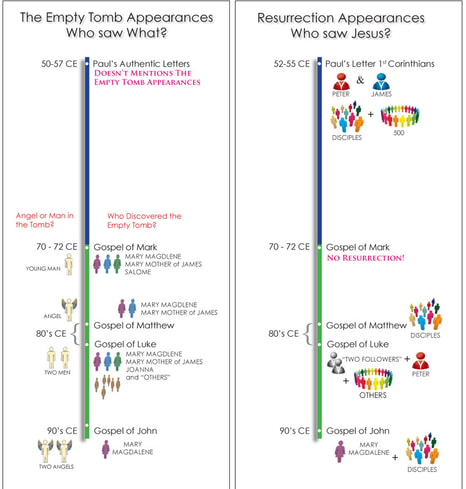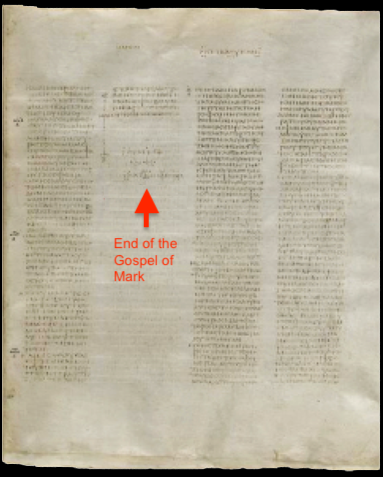|
WAS THE GOSPEL OF MARK CORRECT — THERE WAS NO RESURRECTION? DON'T BELIEVE ME? READ ON.  We ended Installment 1 by saying that it is through the reading of Paul’s letters that we find out what was being transmitted by word of mouth, and believed about Jesus, around 50-55 CE (Common Era—the same as AD)—20 years after Jesus had died. To put this problem of having no written records about Jesus for at least 20 (for Paul), and up to 80 years (for the Gospels), after Jesus’ death causes some difficult problems. I’m going to put this gap in having anything but an oral record in perspective by using Martin Luther King Jr. (MLK) as an example in Installment 3 next week. But first, for those that think that the Gospels are inerrant and in lock-step with one another, let me just show you one example of how the stories changed over the years. Refer back to last weeks’ blog, where I showed the timeline for early Christianity and the writing of the Gospels. Now, let’s quickly look at how the Gospels recorded the appearances of Jesus after he was killed; first at the empty tomb, and second, in front of whom he appeared, and when, as recorded in the Gospels. What was the resurrection of Jesus like? You really can’t tell by reading the Gospels, because they don’t always agree. Mark (the first Gospel written) doesn’t mention any appearance of Jesus (of any kind) after his death. Surprised? The first accounts we have of an appearance of Jesus are in Matthew and Luke, written perhaps 50 years after Jesus’ death—but there is no appearance in Mark! Take a look at the graphics that I prepared to summarize the empty tomb, and resurrection timeline and appearances in the Gospels and in Paul’s writings. Then next week I’ll give you an example of how these diverse stories about a singular event can happen by using Martin Luther King Jr. as an example. Watch for that next week. To understand the resurrection, we have to dig into the records that we have of the event. The appearances of Jesus after he died lie first in the writings of Paul, and then later in the four Gospels: Mark, Matthew, Luke and John. I’m going skip Paul for just a short while, and start with the book of Mark.  Ending of the Gospel of Mark—Mark 16 v9-20 missing! No Resurrection - Codex Sinaiticus Ending of the Gospel of Mark—Mark 16 v9-20 missing! No Resurrection - Codex Sinaiticus MARK In the original version of this Gospel of Mark, three women (Mary Magdalene, Mary the mother of James, and Salome) approached the tomb to find a “young man clothed in white” who says, “Jesus is going ahead of you to Galilee.” [see the graphic above] The Gospel then ends at Mark 16:8 with these words, “The women fled from the tomb, trembling and bewildered, too frightened to talk.” That’s the end! The women fled and they don’t speak to anyone. There is no appearance of Jesus recorded at all. For those of you looking at your bibles and thinking, what about the end of Mark in some versions of the bible, Verses 9 through 20 that record Jesus’ appearance to the women and the disciples? These verses were added centuries later, so that the ending would match the story in Luke. These verses are not found in the most ancient manuscripts (see Codex Sinaiticus, the oldest version of Mark that we have, written about 350 CE). MATTHEW Another decade or more passed (after the Gospel of Mark first appeared), before the gospels of Matthew and Luke were written. As they composed their own gospels, in different countries and different cultures, we see that they have both copied large portions of Mark’s gospel into theirs—word for word—blending and adding to the narrative where they thought that it was needed to comport with the traditions and stories that they had received from those that had come before them, and taking into account the very different world that they now lived in. Matthew drops Salome out of the story, then adds to the significance of Mark’s discovery of Jesus’ empty tomb by telling us that it wasn’t just a young man dressed in white, but rather it was now an “angel of the Lord.” “His face shone like lightning and his clothing was a brilliant white. The guards shook with fear when they saw him, and fell into a dead faint.” (Matt 28:2-4) The story is growing. The unsatisfactory ending of Mark—without any mention of a Jesus appearing to anyone after his death—has now, in the intervening years, been finished. In Matthew’s version of the empty tomb story he tells us that the two women who discovered the empty tomb (no mention of the woman named, Salome, in this story), “…were running, suddenly Jesus was there in front of them!” (Matt 28:9) Matthew believes that the two women who went to the tomb were the first to see Jesus raised from the dead. “‘Good morning!’ he [Jesus] said. And as they fell to the ground before him, holding his feet and worshiping him he said, ‘Don’t be frightened! Go tell my brothers to leave at once for Galilee, to meet me there.’” (Matt 28) We finish with Matthew’s story with Jesus promising the women that he will next appear to the disciples in Galilee, and so he does, “Then the eleven disciples left for Galilee, going to the mountain where Jesus had said they would find him. There they met him and worshiped him…” (Matt 28:16-17) LUKE Next we move to Luke, where it is neither two nor three women that go to the tomb (Mark and Matthew), but now there are many women! “Mary Magdalene and Joanna and Mary the mother of James, and several others.” (Luke 24:10) They don’t encounter an angel of the Lord, nor do they encounter a man, but now they see two men, “clothed in shining robes so bright their eyes were dazzled. (Luke 24:4) Luke has a different story as to where Jesus appeared to his disciples. Now instead of telling “Mary Magdalene and the other Mary” to tell the disciples to go to Galilee where he will meet them, Luke has Jesus appearing in and around Jerusalem. In Luke’s version of what happened, the disciples never go to Galilee! How can that be? Shortly thereafter, in Luke’s chronology, Jesus appears first to two followers in Emmaus (near Jerusalem). They rush back to Jerusalem to tell the disciples the exciting news. But, before they can tell their story, the followers of Jesus greet them with these words, “The Lord has really risen! He has appeared to Peter.” While they are all talking about the exciting news, “Jesus himself was suddenly standing there among them, and greeted them” (Luke 24) JOHN Hang on now. Ten to twenty years further down the road, John writes that only Mary Magdalene came to the tomb and saw no one. She then runs to get Peter and another disciple (the author of the Gospel of John?) to show them the empty tomb, and they see no one. Later, after the two men go back to the city, she returns to the tomb once more. This time she is greeted by two angels, and then Jesus himself! Later that evening as the disciples hid “behind a locked door” Jesus appeared to the disciples in the hidden room. The same thing happened eight days later, again in a locked room. (John 20) Because the author of John had all of the Gospels to draw from, he now wanted to cover the unexplained Galilee references in the two earlier Gospels so he says, almost as an afterthought, “Later Jesus appeared again to the disciples “beside the Lake of Galilee.” (John 21:1) Really, John, that’s the best you can do? A far more plausible explanation is that whatever the real story was, it changed. As time went on, the story grew, and we always have to remember that each of the Gospels were written in different countries, and decades apart, so no wonder they changed. What really happened? That my friend, can never be reasoned out for sure, but we don’t have to believe that every word of each Gospel is the absolute historical record of the event, that just causes us to suspend the common sense God gave us. I think that we can say for sure that something happened, something special, that was so life changing that those early followers were changed for all time. I know that these “miraculous” things can happen, because something similar happened to me. You can read all about that by going to my memory. To be continued with Installment 3 |
AuthorArchitect, software CEO, 30-year student of the historical Jesus and early Christianity. Show host of AuthorTalk, interviewing religious and spiritual authors. Archives
May 2017
|

 RSS Feed
RSS Feed


